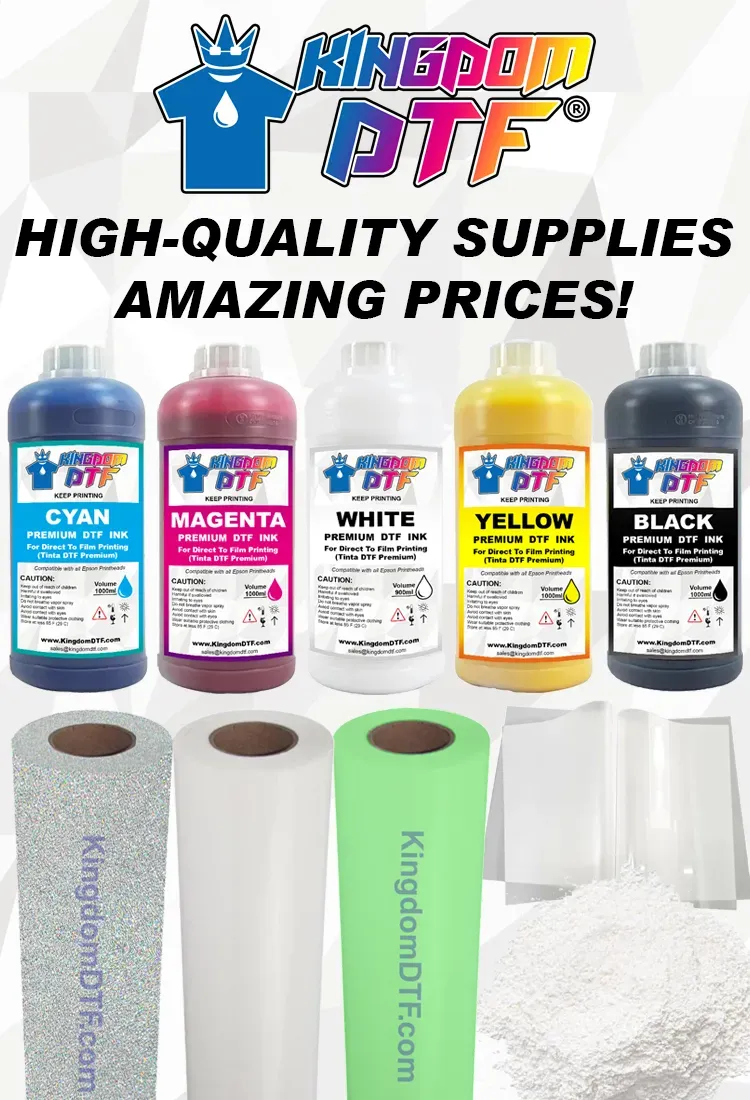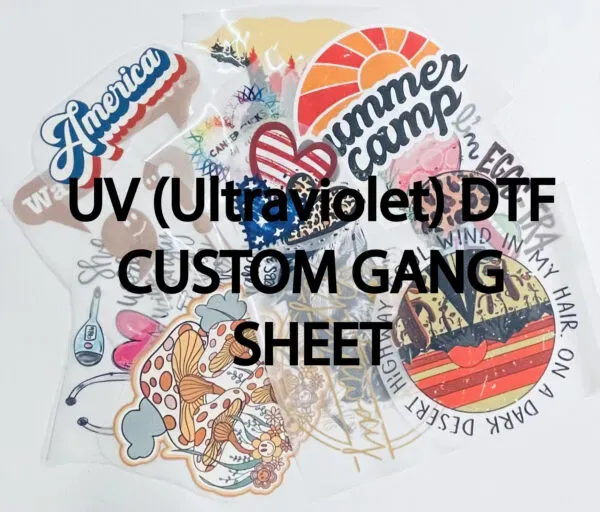UV DTF Gangheet: A Game-Changer for Textile Businesses
UV DTF Gangheet is revolutionizing the landscape of textile printing by combining state-of-the-art UV printing technology with the convenience of direct-to-film processes. This innovative method, highlighted by the **UJV300DTF-75** from Mimaki, enhances print quality while offering unparalleled versatility and sustainability. Businesses in the textile industry can now leverage custom textile solutions to produce vibrant, durable prints tailored to consumer demands. With an increasing focus on sustainable printing practices, UV DTF Gangheet also aligns perfectly with eco-friendly initiatives, making it a top choice for forward-thinking companies. As the textile market continues to evolve, embracing UV DTF technology is essential for those aiming to maintain a competitive edge.
The emergence of UV Direct-to-Film gangheet printing is transforming how textiles are printed and customized. By integrating advanced UV printing techniques with the benefits of direct-to-film methodologies, this approach facilitates high-quality prints across various surfaces. The innovative UJV300DTF-75 printer exemplifies how businesses can cater to the diverse needs of today’s consumers, providing options for personalized items that resonate with individual styles. Furthermore, the eco-focused aspects of this technology support the industry’s increasing shift toward sustainable printing solutions. Such versatility not only broadens product offerings but also enhances operational efficiency, positioning textile companies to thrive in a competitive marketplace.
Revolutionizing Textile Printing with UV DTF Technology
In the ever-evolving textile industry, the introduction of UV DTF technology marks a pivotal transformation. This innovative printing method merges the precision of UV printing with the adaptability of Direct-to-Film applications, positioning it as a leading solution for businesses seeking versatility and quality. Unlike traditional printing methods, UV DTF allows for a wider array of materials to be printed on, including textiles, ceramics, and plastics, providing significant benefits for manufacturers aiming to diversify their products.
Moreover, the recent launch of the Mimaki UJV300DTF-75 exemplifies the capabilities of UV DTF technology, showcasing its potential to deliver intricate designs with exceptional vibrancy. This printer enhances the production capabilities of textile businesses by reducing the setup time associated with conventional printing techniques, allowing for rapid prototyping and production runs. As custom textile solutions become increasingly sought after, UV DTF technology stands out as a vital driver of innovative offerings.
Quality and Customization with UV DTF Gangheet Printing
UV DTF gangheet printing delivers remarkable quality that is revolutionizing the way textile businesses operate. By utilizing state-of-the-art UV inks, which are designed to be both vibrant and durable, businesses can achieve striking print results that meet consumer demands for personalization. The versatility of this technology allows for high-definition graphics and complex designs, ensuring that products stand out in a saturated market where consumers increasingly seek unique and tailored items.
The ability to customize prints using UV DTF gangheet techniques gives textile businesses a significant edge. With reduced misprints and precise detailing, businesses can cater to niche markets that prioritize personalization, such as custom apparel, promotional items, and unique décor. This emphasis on quality and customization not only satisfies consumer preferences but also fosters brand loyalty and repeat business, crucial elements for sustainability and growth in the textile sector.
Sustainability in Textile Production with UV DTF Technology
In today’s eco-conscious environment, sustainability is a critical factor in textile manufacturing. UV DTF technology addresses this need by utilizing environmentally friendly UV inks, which significantly minimize waste and reduce harmful emissions typically associated with traditional printing methods. By adopting UV DTF techniques, textile businesses can substantially decrease their ecological footprint, aligning their operations with modern sustainability standards.
As consumers become more aware of the environmental impact of their purchases, businesses that prioritize sustainable practices are more likely to attract a loyal customer base. The UV DTF gangheet printing process not only aligns with consumer values but also enhances a business’s reputation as a responsible and forward-thinking participant in the textile industry. This shift toward sustainable textile printing is not just a trend; it’s become a crucial strategy for long-term success in a market that increasingly prioritizes eco-friendly solutions.
Versatile Applications of UV DTF Printing
One of the standout features of UV DTF printing is its versatility across various applications. This technology empowers textile businesses to produce an extensive array of products, ranging from clothing and accessories to promotional materials and signage. The ability to print on both rigid and flexible surfaces opens new avenues for creativity and product development, allowing companies to cater to diverse market needs and preferences.
For instance, with UV DTF technology, businesses can easily transition between printing t-shirts to creating custom drinkware, offering a complete range of personalized products. This adaptability not only increases production efficiency but also enhances cross-selling opportunities, enabling companies to explore new markets and strengthen their brand presence across multiple platforms.
Efficiency and Cost-Effectiveness of UV DTF Gangheet Printing
Efficiency is a cornerstone of UV DTF gangheet printing, making it an attractive option for textile businesses looking to streamline their operations. Advanced features of printers like the Mimaki UJV300DTF-75 include roll-to-roll capabilities and automated cutting systems, which minimize production bottlenecks and enhance throughput. This level of efficiency translates into faster turnaround times, allowing businesses to meet urgent customer demands without compromising on quality.
Moreover, the cost-effectiveness of UV DTF technology is evident in reduced operational costs. By cutting down on labor-intensive processes and maximizing output, businesses can significantly improve their profit margins. The relatively low material costs associated with UV inks further bolster the financial viability of adopting this technology, encouraging businesses to invest in UV DTF as a long-term solution for growth and profitability.
Market Implications of UV DTF Gangheet Technology
The advent of UV DTF gangheet technology has substantial market implications for the textile industry. As businesses harness this innovative printing method, they can better meet the growing consumer demand for high-quality, customizable products. This technology not only enhances production capabilities but also allows companies to engage with customers on a personal level, leading to increased loyalty and sales.
Furthermore, implementing UV DTF technology can give businesses a competitive edge. By capitalizing on the quality and sustainability benefits inherent to this process, companies can differentiate themselves in a robust market. As consumers continue to prioritize personalized and eco-friendly options, businesses able to leverage UV DTF printing will likely position themselves as leaders, driving innovation and success in the industry.
Frequently Asked Questions
What is UV DTF Gangheet and how does it improve textile printing?
UV DTF Gangheet is a cutting-edge printing technology that combines UV printing with direct-to-film techniques, allowing for high-quality prints on various surfaces including textiles. This method enhances print accuracy, versatility, and customization options, providing businesses with the tools to meet market demands effectively.
How does the UJV300DTF-75 printer enhance quality in UV DTF Gangheet printing?
The UJV300DTF-75 printer from Mimaki Europe utilizes advanced UV inks to produce vibrant, durable prints. By improving the transfer printing method, this printer significantly reduces misprints and allows for precise designs, making it an ideal choice for businesses focusing on quality in textile printing.
What are the sustainability benefits of using UV DTF Gangheet technology?
UV DTF Gangheet technology features environmentally friendly UV inks that minimize the ecological footprint of textile printing. By adopting sustainable printing practices, businesses can align with consumer preferences for eco-friendly products, gaining a competitive edge in today’s market.
In what applications can UV DTF Gangheet technology be utilized?
UV DTF Gangheet technology is highly versatile, allowing textile businesses to print on a wide variety of products. This includes apparel like t-shirts and hats, as well as promotional items such as drinkware, enabling businesses to diversify their offerings and capture new market segments.
How does UV DTF Gangheet improve efficiency for textile businesses?
UV DTF Gangheet technology improves operational efficiency through innovations like roll-to-roll capabilities and automated cutting. These advancements streamline production workflows, reduce turnaround times, and lower operational costs, making it a cost-effective solution for scaling textile operations.
What competitive advantage does UV DTF Gangheet print offer in the textile industry?
By leveraging UV DTF Gangheet technology, textile businesses can differentiate themselves with enhanced print quality, sustainability, and customization. This positions them favorably in a crowded market, catering to consumer demands for personalized products, thus enhancing customer engagement and loyalty.
| Key Point | Description |
|---|---|
| What is UV DTF? | A revolutionary printing process that combines UV printing with direct-to-film techniques, allowing for high-quality prints on various surfaces including textiles and metals. |
| Quality and Customization | Utilizes advanced UV inks for vibrant, durable, and customizable prints that meet EU regulations, helping businesses minimize misprints and enhance design accuracy. |
| Sustainability | UV DTF uses eco-friendly inks that reduce the environmental impact compared to traditional printing methods, aligning with consumer demands for sustainable products. |
| Versatility Across Applications | Allows businesses to expand their product offerings significantly, enabling printing on items ranging from clothing to promotional materials. |
| Efficiency and Cost-Effectiveness | Streamlines production workflows through innovations like roll-to-roll capabilities, reducing operational costs and improving turnaround times. |
| Market Implications | Meeting consumer demand for high-quality, customizable products provides businesses with a competitive advantage in a crowded marketplace. |
Summary
UV DTF Gangheet technology is paving the way for a revolutionary shift in the textile industry. This innovative printing technique allows for exceptional quality, sustainability, and vast versatility, empowering businesses to meet the growing consumer demand for personalized and eco-friendly products. As highlighted by advancements such as the UJV300DTF-75 printer, UV DTF gangheet capabilities are crucial for textile companies aiming to enhance operational efficiency and product offerings. By embracing this game-changing technology, businesses can not only stay relevant but also thrive in an increasingly competitive landscape.







